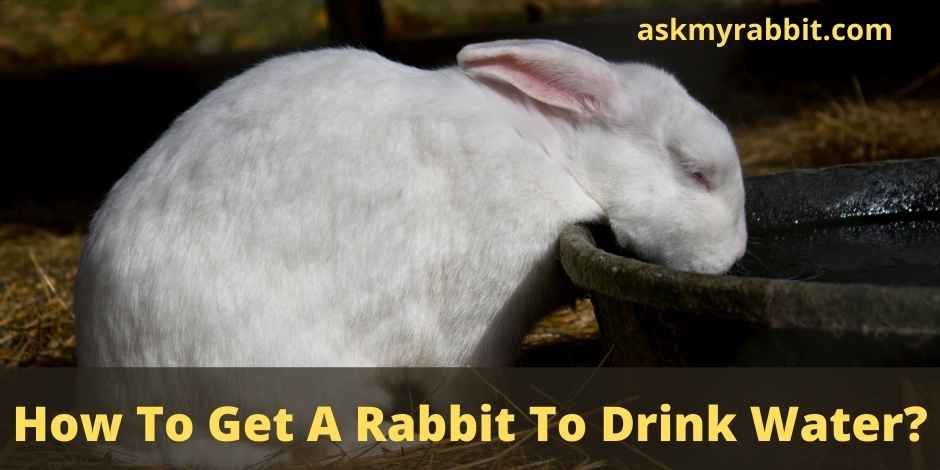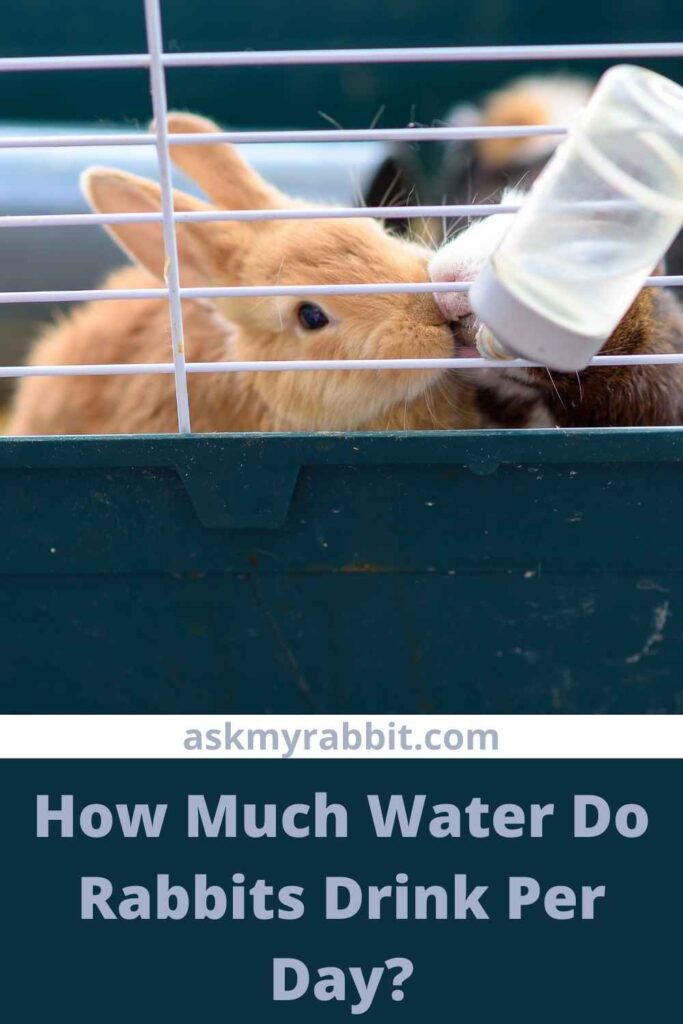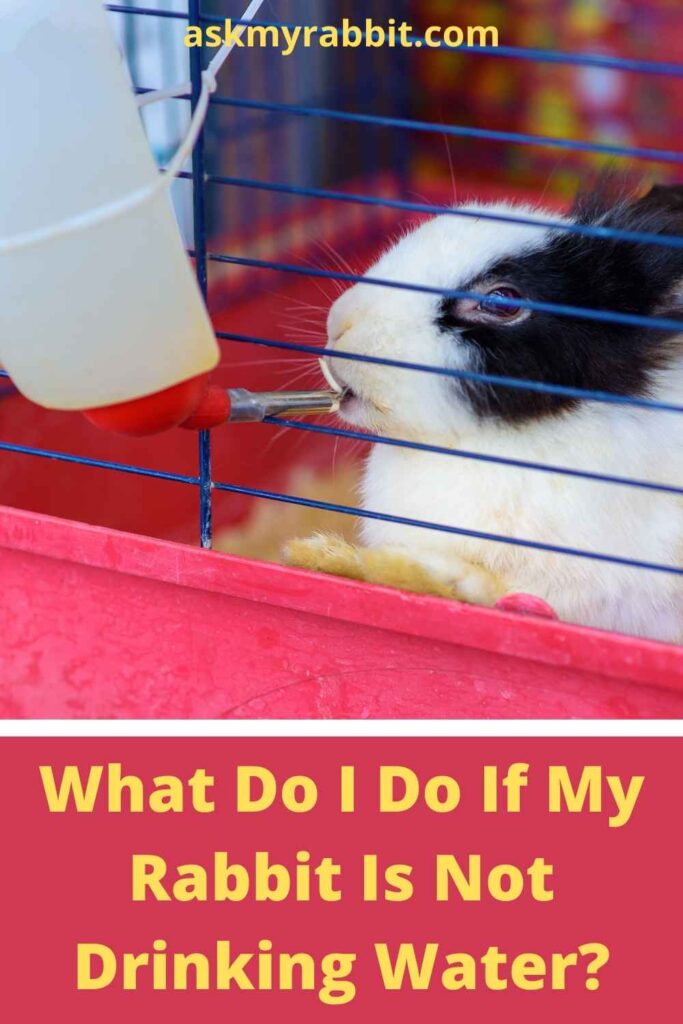The majority of rabbits are capable of controlling their own water intake without the need for human intervention. When they’re thirsty, they’ll drink, and they’ll obtain some water from their usual diet.
However, every now and again, you’ll come across a rabbit who is a little fussy. They won’t drink enough and, as a result, are more likely to become ill. There’s a lot you can do to encourage your rabbit to drink more water in these situations.
So, you may be thinking, what can I do to get my rabbit to drink more water?
Giving your rabbit a big dish to drink from is the greatest way to encourage them to drink more water. This is a more natural method of keeping rabbits hydrated.
If that doesn’t work, try putting little amounts of flavoring in their water dish or encouraging them to drink water while eating their leafy greens.
You may use a variety of techniques to urge your rabbit to drink more. Staying hydrated is crucial for keeping your rabbit’s system working properly and preventing diseases like gastrointestinal Stasis and bladder sludge.
If your rabbit drinks too little on a regular basis, it might be a sign of some underlying ailment. It’s usually a good idea to take them to the veterinarian for a check-up just to make sure.
If you want to learn more about your pet bunny’s drinking requirements, keep reading!

How Much Water Do Rabbits Drink Per Day?

Rabbits, like humans, require continual access to fresh water to thrive. However, the question of how much water your rabbit truly need emerges.
This is a reasonable concern, and if you’re a new rabbit owner or are considering getting one, you should be aware of your rabbit’s nutritional requirements.
Rabbits need to drink around ten percent of their body weight in water on a daily basis. Keep in mind that your rabbit should always have access to fresh water.
This is only a suggestion, as there are several things to consider when determining your rabbit’s water intake needs.
In terms of overall health, each rabbit is unique, and this might influence how much water your rabbit consumes. Another issue to consider is temperature. Rabbits, like people, would need to drink more to stay hydrated if housed in a hotter environment.
In other words, a four pound rabbit should only drink one cup of water each day. Water, on the other hand, should not be rationed by rabbit owners.
The amount of water your rabbit consumes is also influenced by its food. Rabbits who consume more dry food tend to drink more water because their bodies can absorb more water, making them thirstier.
How Often Do Rabbits Need Water?
A normal and healthy rabbit should drink around ten percent of her body weight in water each day. If your rabbit weighs four pounds, she should drink at least 180 millilitres of water every day.
To keep rabbits healthy, one cup of water per day is more than enough. Pour this more than once. For your rabbit’s safety, her water supply should be topped up and replaced on a regular basis.
You’ll also note that none of the water bottles or bowls are smaller than 180ml. This is done on purpose.
Because rabbits like to live in pairs, vessels are designed to accommodate numerous pets. It also lowers the chances of having an empty bowl or bottle for an extended length of time.
How Do I Rehydrate My Rabbit?
Because rehydrating your rabbit is so important, it’s best to get professional aid. Don’t just put a big bowl of water on the table and call it a day.
Even if your pet drinks this water, the problem will not be solved. Rehydration must be done slowly and steadily. Syringe feeding and intravenous fluids are the most effective treatments.
Pick up a syringe from a pet store if you wish to try syringe feeding. Place the syringe in the corner of your rabbit’s mouth and fill it with water.
Water should be released in short, controlled spurts. Between sips, give your pet a chance to swallow and relax.
Take your rabbit to the vet if she refuses to drink or cannot swallow. Your pet will require intravenous fluids. The situation will be critical at this point, so make sure she sees a veterinarian right away.
What Do I Do If My Rabbit Is Not Drinking Water?

If your rabbit refuses to drink water, the first thing you should do is change that. Your main focus at first will be getting some fluids into your pet.
To persuade your rabbit to drink water, try the following methods:
- Changing from a water dish to a bottle or vice versa is a good idea.
- Clean all water vessels thoroughly so that they have a neutral odour.
- Purify or buy bottled water if your rabbit refuses to drink tap water.
- Add some pleasant ingredients to your rabbit’s drink to make it more attractive.
The latter is, without a doubt, the safest option. Mix tiny quantities of unsweetened fruit juice into your rabbit’s water if she refuses to drink.
She’ll rekindle her interest in you shortly. Apple or carrot juice is commonly used. Stop giving her more juice as soon as she begins drinking again.
If you’re not cautious, you’ll find yourself back where you started. Your rabbit will stop drinking water once more, indicating that he is waiting for more juice.
Can You Force A Rabbit To Drink Water?
Giving your rabbit a big dish to drink from is the greatest way to encourage them to drink more water.
If that doesn’t work, try putting little amounts of flavouring in their water dish or encouraging them to drink water while eating their leafy greens.
You may also scoop up some water with lettuce leaves so your rabbit drinks more while eating. Whatever water remains at the bottom of the bowl of leafy greens may also appeal to your rabbit.
How Do You Force Feed A Rabbit Water?
Place your rabbit in a secure location where she won’t be able to back up or flee. This might be between your legs, crisscrossed, or with the assistance of another person to keep her motionless.
Then, with the syringe in her mouth, slowly shoot down a small amount of water at a time. You’ve made progress if she even consumes half of it. Because rabbits aren’t particularly proficient at spitting, your bunny has no choice except to swallow.
However, remember not to fire too quickly, as this may cause her to choke.
Can You Syringe Feed Water To A Rabbit?
If your rabbit isn’t drinking any water, you should pay attention to the issue. It might indicate that anything is significantly wrong with your rabbit’s health, necessitating a visit to the veterinarian.
In the veterinarian clinic, your rabbit will most likely be given an IV to help with hydration. They may also give you instructions for syringe feeding your rabbit at home.
How Do You Syringe Feed A Rabbit?

For a rabbit that is already sick, syringe feeding may be quite distressing. It’s critical that you stay calm and patient when feeding, and that you do it in a peaceful, distraction-free environment.
Make sure you have all of the necessary things on hand and within easy reach. The following things are required:
- Syringes for feeding
- Bibs for babies
- Hand towels, one to wrap the bunny and one for the table
- Paper towels, as needed to clean the syringes / patient
What type and size of syringe you choose will depend on your own preferences. If you’re pre-filling, give the syringe a good shake before feeding because the mixture tends to separate.
Procedure:
- Hold the rabbit in a regular position, such as on all four feet on a table or the floor, or with its head slightly raised, as seen below.
- Assist the rabbit in becoming as comfortable as possible.
- Insert the syringe nozzle into the side of the mouth gently. Instead of pushing it down towards the neck, place it in the centre of your mouth.
- While administering the little amounts of food, make sure the rabbit’s head remains straight.
- To facilitate chewing and swallowing, remove the syringe between mouthfuls.
Some individuals like to feed while sitting on the floor, while others prefer to feed while standing at a table. You should choose whichever approach makes you feel most at ease and in which you believe the rabbit is the most safe. Ideally, you should always have someone to assist you.
Cross your legs and position the rabbit in your lap with their bottom and back legs in between your crossed legs if you’re seated on the floor. Place their front legs over your thigh after that.
This posture prevents them from reversing and gives you easy access to grasp their head and feed them while they remain in a natural, upright position. If desired, they might be towel wrapped before being placed.
If you’re standing at a table, make sure the rabbit can’t easily reverse or jump off. Wrap the patient in a towel or just stand them on a towel with their bottom touching your chest and your arm hugging the side of their body if the patient is calm. Alternatively, have one person retain this position while the other feeds.
How Much Water Should I Force Feed My Rabbit?
To provide a suitable quantity, it is typically recommended that you feed around 8-12ml/kg of the combination four times a day. However, it is critical to follow your patient’s lead, since some rabbits will not tolerate this much or will require lower doses more regularly.
Because assisted feeding might boost the rabbit’s hunger, make sure to immediately follow up with some appetising fresh food in the cage.
How Long Should You Syringe Feed A Rabbit?
Syringe feeding or force feeding your rabbit is a critical element of healing from gastrointestinal stasis and in some circumstances, the most critical part of recovering from surgery or sickness.
It’s crucial to be kind and persistent with your rabbit, since ensuring proper food intake might be the difference between healing and death.
While the type of food and water content of the preparation being fed may vary, you should try to feed your rabbit every two to six hours while they are not eating.
It will get increasingly harder to syringe feed the bunnies as their health improves. Assisted feeding can be discontinued if they are eating modest quantities on their own.
When To Stop Syringe Feeding Rabbit?
Between mouthfuls, the syringe should be withdrawn and the rabbit’s head rubbed to promote this. To reduce the risk of aspiration and choking, the feeding should be halted and the patient re-evaluated if the rabbit refuses to swallow at all.
When rabbits are sick, syringe feeding them by hand may make a world of difference. Always consult your rabbit’s veterinarian to determine the source of the hunger problem.
Not eating is a sign of a deeper issue. A rabbit that isn’t eating is typically ill, in discomfort, or suffering from a medication response. Until he’s on the mend, your vet will devise a treatment plan that includes syringe feeding.
When you notice your bunny getting better, you may stop syringe feeding.
Frequently Asked Questions
Can You Syringe Water To A Rabbit?
Yes, you can syringe water to a rabbit. Place the syringe beneath the incisors of your rabbit’s mouth. Slowly let go of the syringe, keeping it sideways to keep the water out of your rabbit’s trachea. Allow enough time for your rabbit to drink the water or, if you’re feeding him, to chew and swallow the food.
How Many Days Can Rabbits Go Without Water?
Rabbits can’t go without water for more than twenty-four without suffering significant health repercussions.
How Often Should You Syringe Feed A Rabbit?
You should syringe feed a rabbit every two to six hours.
Final Words
Your rabbit must have access to fresh, clean water at all times. It doesn’t matter if it’s from a water bottle or a water bowl, each has its own set of advantages and disadvantages.
Don’t be alarmed if your rabbit drinks little more or less than the required ten percent of its body weight. This might be due to the area it lives in or even its eating habits.
Consult a veterinarian if your rabbit is consuming an unsafe quantity of water, such as none at all or a lot. This will not only guarantee that your rabbit’s health is examined as soon as possible, but it will also provide you with the comfort that you require as a bunny owner.
Drop down your queries regarding your pet bunny in the comment section below. We will answer them soon!






